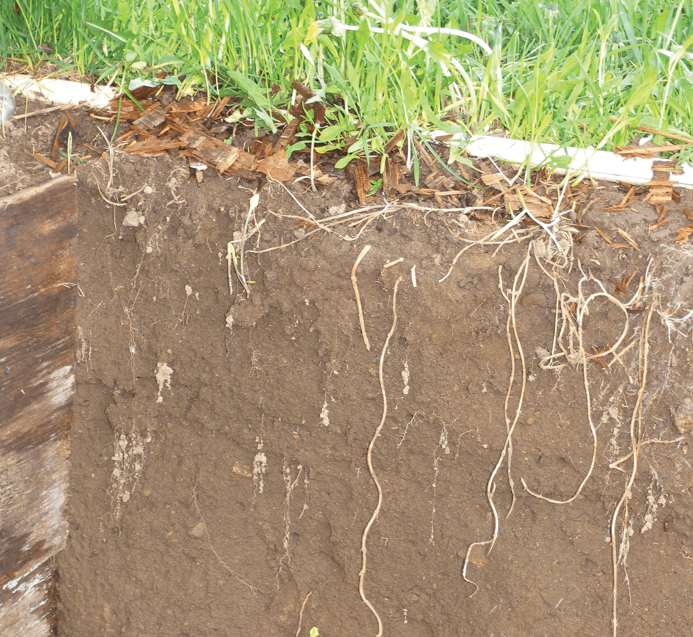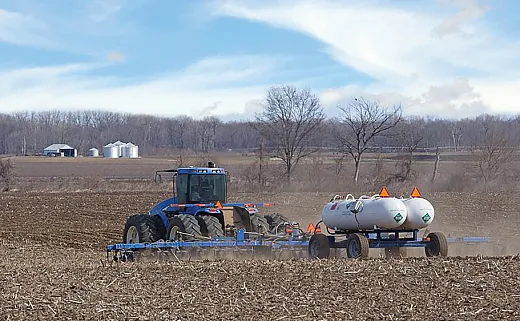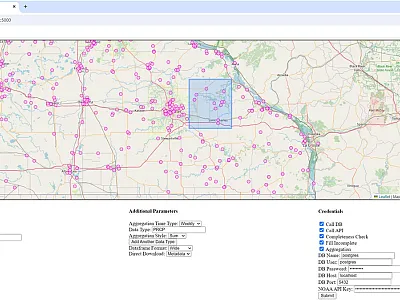An Ace in the Hole for Soil Health and Nitrogen Tracking
ACE Protein Provides First Solid Measurement of Organic Nitrogen in Soils

- Organic nitrogen constitutes the vast majority of the total nitrogen in arable soils, but since there hasn’t been a reliable method to measure it, many studies focus solely on inorganic nitrogen.
- Scientists have recently confirmed that ACE protein—autoclaved‐citrate extractable protein—works well to measure the organically bound pool of nitrogen in soil.
- ACE protein also provides much‐needed information about total nitrogen as well as nitrate and ammonium—inorganic nitrogen sources—and reveals how sustainable management practices can promote soil health.
Organic nitrogen constitutes the vast majority of the total nitrogen in arable soils. Yet many studies focus solely on inorganic nitrogen—that which is readily available for plants to use.
Why? “There just hasn’t been a reliable method” to measure organic nitrogen, says Society member Katherine Naasko, a post‐doctoral researcher in the Soil Health & Ecosystem Ecology Lab led by Christine Sprunger at Michigan State University. Measuring inorganic nitrogen is hard enough, especially in higher rainfall environments, adds Steve Culman, a soil health scientist at Washington State University. Measuring soil health in general is also challenging. But getting a good handle on soil health and the amount of nitrogen in the soil—and the amount leaking out, whether in the water or the air—is important.
So, scientists like Naasko and Culman (Society members as well) have been exploring new ways to measure organic nitrogen in soil and whether such ways can also offer information on overall soil health or other pools of soil nitrogen. Naasko and co‐authors recently confirmed that ACE protein—autoclaved‐citrate extractable protein—works well to measure the organically bound pool of nitrogen in soil. But ACE protein also provides much‐needed information about total nitrogen as well as nitrate and ammonium—inorganic nitrogen sources—and reveals how sustainable management practices can promote soil health.

What Is ACE protein?
“ACE protein is defined as the organically bound nitrogen fraction in the soil,” Naasko explains. Within soil are both organic and inorganic fractions of nitrogen. Most research focuses on inorganic fractions—nitrate and ammonium—or total nitrogen, which tries to estimate organic fractions plus inorganic. So even though organic nitrogen constitutes 90 to 99% of soil nitrogen, it’s mostly not being accounted for. “It’s just the state of the science,” Naasko says. “We haven’t had a reliable, high‐throughput metric for it so far.” For the last five years or so, scientists have been trying to determine if ACE protein could be used as a viable indicator of soil nitrogen availability.
Tracking Soil Nitrogen
“Nitrogen management is very hard because nitrogen itself is like a shapeshifter—it leaves the soil in so many ways,” Culman says.
One of the challenges of measuring nitrogen is figuring out mineralization rates—how quickly and how much of the organic nitrogen in soil can be converted by microorganisms into bioavailable inorganic nitrogen. Before you can quantify mineralization rates, though, you need to quantify the pool of organic nitrogen that can be mineralized. In a 2018 study in Agricultural & Environmental Letters (https://doi.org/10.2134/ael2018.02.0006), Culman and colleagues found that measuring ACE protein could work to quantify that pool. It worked so well that it could be included in commercially available soil health assessments, they noted. In a 2021 book that was part of SSSA’s Soil Health Series (https://doi.org/10.1002/9780891189831.ch10), Culman and Tunsisa Hurisso further noted how important it is to determine organic soil nitrogen and that ACE protein “shows promise for rapid, sensitive quantification of functionally relevant soil nitrogen pools.”
In a 2023 paper in the Soil Science Society of America Journal (https://doi.org/10.1002/saj2.20600), Naasko and colleagues furthered this line of study with similar conclusions: ACE protein provides a great measure of the pool of organic nitrogen that’s available, and it’s related to yield.
Naasko and her colleagues looked at results from soils extracted from study fields at the Kellogg Biological Station Long‐Term Ecological Research site in Michigan. The fields have been managed in eight different ways over the past three decades or so, allowing for comparisons of how different agronomic management techniques affect soil health. Management history varies between annual row crop systems and polyculture perennials. The annual row crop systems rotate among soy, corn, and wheat and are managed with varying levels of tillage and chemical inputs. The polyculture perennials have yearlong ground cover and aggregate‐stabilizing root structures that are managed less intensively with respect to tillage, fertilization, and so on.
Among these fields, Naasko and co‐authors looked at ACE protein levels, as well as ammonium, nitrate, and total nitrogen levels, at four time points across a growing season.

What Does This Pool of Organic Nitrogen Show Us?
First, Naasko and her colleagues found that although nitrogen in general shows a lot of variability through the growing season, ACE protein fluctuated far less than total soil nitrogen, nitrate, and ammonium across the growing season. The stability of ACE protein levels “astonished me,” Naasko says. This “shows the potential for ACE protein to serve as a reliable indicator of soil health and soil organic nitrogen status,” the team wrote.
However, because nitrogen—especially more ephemeral inorganic forms, and thus also total nitrogen—does vary significantly through a growing season, Culman stress that when in the growing season you test for nitrogen matters. Fall is a common time, especially in the Midwest, to measure nitrogen levels and soil health levels in general, he says. Soils are relatively dry then and you have more time—you’re not crunched with planting. “We would not recommend sampling in midseason,” he says. Just be consistent when you test year after year, and you’ll have a better sense of overall trends.

Second, Naasko and co‐authors found a positive correlation with ACE protein levels and yields: the higher the soil protein levels, the higher the yield rates. Yield increases with higher ACE protein levels were observable across different management systems. However, perennial crops showed significantly higher protein levels relative to the annual systems. “That’s an important piece no one has really shown,” Culman says. It makes sense, but “it’s good to see this temporal trend with soil protein levels increasing over time” in these perennial systems.
One mown grassland system, which was planted in 1959 and not tilled, showed a mean ACE protein level of 16.34 g kg–1; a conventionally tilled annual row crop system, meanwhile, showed a mean ACE protein level of 3.95 g kg–1. No‐till soy was slightly higher than the conventional field. “On average,” Naasko and colleagues wrote, “polyculture perennial systems that promote soil health had two to four times higher ACE protein concentrations compared with annual cropping and monocultural perennial systems.”
The differences between annual and perennial systems are “robust,” Culman says.
Third, the team found that ACE protein amounts could be positively correlated with total nitrogen levels and ammonium levels but negatively correlated with nitrate levels. It makes sense, Naasko says, that ACE protein levels would strongly correlate with total nitrogen since organic nitrogen makes up most of the total nitrogen in the soil. “So you can really get a good idea of how your total nitrogen is changing.” And ACE protein correlates also with ammonium though to a less extent. “But correlations between ACE protein and nitrates are negative or nonexistent,” she says. “That points to the identity of ACE protein as this organically bound soil nitrogen fraction that accumulates and accrues in sustainable management systems.”
Comparisons
The findings show the value of these long‐term agroecological research sites where you can compare results of different management styles over a long period of time in one field because the weather, climate, soils, and other otherwise‐complicating factors are all consistent, Naasko notes. Seeing such stark differences among perennial systems and those managed more for soil health, rather than conventional annual systems, is “really cool,” she says. “You end up with more organically bound nitrogen, more ammonium, and more total nitrogen in these perennial polyculture systems.”
That said, even though research like this shows the value of soil health indicators like ACE protein, it’s not a one‐size‐fits‐all answer to measuring nitrogen rates or soil health, Naasko and Culman both say. At the risk of sounding cliché, it’s one more tool in the toolbox that we can use to understand the soils, Culman says. “It’s important to measure more than just one soil health indicator,” Naasko adds.
But testing ACE protein is quicker, easier, and should be cheaper than other nitrogen tests, especially total nitrogen tests, Culman notes. It can be done wet or dry, unlike most tests, and you could run hundreds of these easily in a single day at a commercial lab. And because ACE protein, in the form of organic nitrogen, makes up 90 to 99% of total nitrogen, knowing the amount of ACE protein would thus give you a good sense of your total nitrogen.
Testing ACE protein is quicker, easier, and should be cheaper than other nitrogen tests... And ... knowing the amount of ACE protein would give you a good sense of your total nitrogen.
What Does the Future Hold?
Nitrogen is often a limiting factor for crops and thus needs to be added to many crops, but historically, too much has often been added, partly because there are so few reliable methods to measure what’s already there. There are global consequences for excess nitrogen, Culman says, so it is important to get a handle on what’s being added. In addition, every bit of fertilizer a grower adds to a field costs real money.
Trying to time nitrogen availability with crop demand is the holy grail, Culman says. Using ACE protein as a predictive tool is where we want to go, so we can time release of nitrogen over the growing season when plants most need it. But we’re not there yet.
Figuring out mineralization rates is part of that predictability factor, but it is a tall order, Culman says. Like everything in agronomy, mineralization rates constitute a “local experience,” he says. Everything differs depending on where you are in the country, or even a state or region or farm or field. Soils, weather, climate, morphology, and crops—they’re all going to change the processes and rates of mineralization. But with tools like using ACE protein to track nitrogen levels, we can eventually tailor fertilizer recommendations, he says. At least that’s the hope. “It’s like we know that a car is made up of tires and fenders, motors, seats, and all these things, but how do they all fit together for a common function?” Culman says. In terms of nitrogen, thanks to research like this, we know more of the parts that go into figuring out how nitrogen moves through the system, and we’re on our way to understanding how to put the “car” together.
DIG DEEPER
Check out some of the research mentioned in this article:
Naasko, K., Martin, T., Mammana, C., Murray, J., Mann, M., & Sprunger, C. (2024). Soil protein: A key indicator of soil health and nitrogen management. Soil Science Society of America Journal, 88, 89–108. https://doi.org/10.1002/saj2.20600
Hurisso, T.T., Moebius‐Clune, D.J., Culman, S.W., Moebius‐Clune, B.N., Thies, J.W., & van Es, H.M. (2018). Soil protein as a rapid soil health indicator of potentially available organic nitrogen. Agricultural & Environmental Letters, 3, 180006. https://doi.org/10.2134/ael2018.02.0006
Hurisso, T.T., & Culman, S.W. (2021). Is autoclaved citrate‐extractable (ACE) protein a viable indicator of soil nitrogen availability? In D.L. Karlen, D.E. Stott, & M.M. Mikha (Eds.), Soil Health Series: Volume 2. Laboratory methods for soil health analysis (pp. 176–193). SSSA. https://doi.org/10.1002/9780891189831.ch10
Text © . The authors. CC BY-NC-ND 4.0. Except where otherwise noted, images are subject to copyright. Any reuse without express permission from the copyright owner is prohibited.







